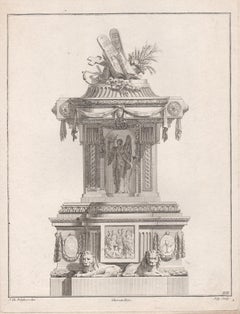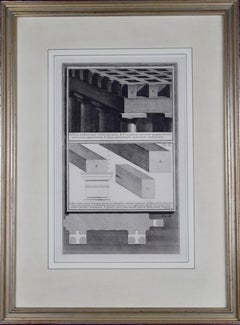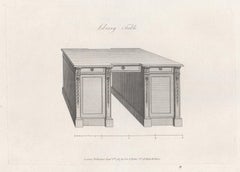18th Century Interior Prints
to
5
38
31
15
5
15
Overall Width
to
Overall Height
to
19
4
1
16
15
4
3
2
127
223
1,119
768
11
13
21
53
36
85
86
217
251
84
104
65
38
1
56
26
17
17
12
8
5
5
5
5
4
4
4
3
3
3
2
2
2
2
73
28
24
17
5
29
12
40
28
Period: 18th Century
Deutzia Flowers: The Wife of Kasamori - Original Woodblock Print
Located in Soquel, CA
Deutzia Flowers: The Wife of Kasamori - Original Woodblock Print
Deutzia Flowers: The Wife of Kasamori, from the Series "Beauties of the Floating World Associated with Flowers" by S...
Category
Edo 18th Century Interior Prints
Materials
Woodcut, Ink, Rice Paper
French Neoclassical design for a Pulpit, engraving after Delafosse
Located in Melbourne, Victoria
Copper-line engraving. C1768.
Delafosse was a French decorative designer, engraver and architect. Apprenticed for a time to a sculptor, by 1767 he styled himself an 'architect and professor of design'. He published the first volume of his most important work, 'Nouvelle Iconologie Historique' in 1768, containing 110 plates of his designs for furniture, decorative arts and architectural...
Category
French School 18th Century Interior Prints
Materials
Engraving
French Neoclassical Design engraving for Braziers
Located in Melbourne, Victoria
Copper-line engraving. C1768.
Delafosse was a French decorative designer, engraver and architect. Apprenticed for a time to a sculptor, by 1767 he styled himself an 'architect and professor of design'. He published the first volume of his most important work, Nouvelle Iconologie Historique in 1768, containing 110 plates of his designs for furniture, decorative arts and architectural...
Category
French School 18th Century Interior Prints
Materials
Engraving
T. Gaugain after James Northcote - 1796 Engraving, Modest Girl In Her Chamber
Located in Corsham, GB
A fine 18th Century engraving showing a pious young woman kneeling in prayer at the edge of her bed. The scene comes from a series of engravings published to she the differences between the lives of "wanton" girls and "good" girls. There is an illuminated inscription at the lower edge with various Bible...
Category
18th Century Interior Prints
Materials
Engraving
18th Century Etching of Ancient Roman Architectural Objects by Giovanni Piranesi
Located in Alamo, CA
A. Tigna Protensa Super Media Epistylia, B. Praecisiones Tigorum Quaqua Versus Extrinsectus Apparentium, C. Opae Extremitates Tigorum Contintes, Fig. I, plate 88 from "Vasi, Candelab...
Category
Old Masters 18th Century Interior Prints
Materials
Etching
Library Table, Hepplewhite English Georgian furniture design engraving
Located in Melbourne, Victoria
'Library Table'
From George Hepplewhite's 'Cabinet-Maker and Upholsterer's Guide', published by I. and J. Taylor in 1788. These engravings are the only evidence of Hepplewhite's sty...
Category
English School 18th Century Interior Prints
Materials
Engraving
La Messe (The Mass), after Caravaggio
Located in Middletown, NY
Chiaroscuro woodcut with underlying engraving on cream laid paper, printed from two blocks in brown and olive. 10 1/4 x 12 3/4 inches (260 x 321 mm) (plate), full margins with the text printing clearly below in black ink. In very good condition with scattered surface soiling and several minor flecks of light discoloration in the margins, especially in the area of the lower right corner, well outside of image area. Unobtrusive notations in pencil in the margin and on the verso. All condition issues are consistent with age. After a drawing of the same title by Polidoro da Caravaggio...
Category
Old Masters 18th Century Interior Prints
Materials
Laid Paper, Engraving, Woodcut
Rococo design for a gate, German mid 18th century etching
Located in Melbourne, Victoria
Rococo design for a gate, etching, by Joseph Baumann (active 1740-1760), circa 1750.
Published by Martin Engelbrecht (1684–1756).
Similar works ar...
Category
Rococo 18th Century Interior Prints
Materials
Engraving, Etching
Library Case, Hepplewhite English Georgian furniture design engraving
Located in Melbourne, Victoria
'Library Case'
From George Hepplewhite's 'Cabinet-Maker and Upholsterer's Guide', published by I. and J. Taylor in 1788. These engravings are the only evidence of Hepplewhite's styl...
Category
English School 18th Century Interior Prints
Materials
Engraving
Différentes Especes de Buffets et Leurs Developments, French design engraving
Located in Melbourne, Victoria
'Différentes Especes de Buffets et Leurs Developments'
(Different types of buffet and their formation)
French copper-line engraving by PL Cor after Andre Jacob Roubo (1739–1791). 18...
Category
Naturalistic 18th Century Interior Prints
Materials
Engraving
Piranesi VI.
Located in Slovak Republic, SK
Fine Art Print Hahnemuehle, edition, Giovanni Battista Piranesi print in Verlag von Ad Lehmann in Wien, end of 19 Century.
Category
Italian School 18th Century Interior Prints
Materials
Black and White, Archival Pigment
$1,039 Sale Price
20% Off
Side Board, Hepplewhite English Georgian furniture design engraving
Located in Melbourne, Victoria
'Side Board'
From George Hepplewhite's 'Cabinet-Maker and Upholsterer's Guide', published by I. and J. Taylor in 1788. These engravings are the only evidence of Hepplewhite's style ...
Category
English School 18th Century Interior Prints
Materials
Engraving
Allegory of the four seasons. Four engravings on two framed sheets.
Located in Paris, FR
Allegory of the four seasons. A pair of engravings.
These engravings are framed in white gold covered french frames.
From the publication published in Milan in 1782.
"Different ornam...
Category
18th Century Interior Prints
Materials
Engraving
FEOLI. Vedute del Museo Pio-Clementino
Located in London, GB
Magnificent large plate illustrating the Vatican Museum at the end of the eighteenth century by Vincenzo Feoli (1750 - 1831) after Micenelli and Costa.
The Pio-Clementino museum, na...
Category
Naturalistic 18th Century Interior Prints
Materials
Engraving, Handmade Paper
Piranesi IV.
Located in Slovak Republic, SK
Fine Art Print Hahnemuehle, editioned, Giovanni Battista Piranesi print in Verlag von AD Lehmann in Wien, end of the 19. century, SalamonArt certificate will be included.
Category
Italian School 18th Century Interior Prints
Materials
Archival Pigment
$264 Sale Price
79% Off
Ancient Roman Marble Vase: 18th C. Piranesi Etching Vaso Cinerario di Gran Mole
Located in Alamo, CA
"Vaso Cinerario di Gran Mole. Le Teste dei Giovenchi mostrano di reggere it pesante Festone composto di Frutti Fiori Grans ed use. Il tuto Necefsario all Vita Umana. Il Restante degl...
Category
Old Masters 18th Century Interior Prints
Materials
Etching
Frontispiece from "Carceri d'Invenzione" - Etching by G. B. Piranesi - 1749/59
Located in Roma, IT
Carcere d'Invenzione is an original Modern Artwork realized by Giovan Battista Piranesi (Mogliano Veneto, 1720 - Rome, 1778).
Original Etchin...
Category
Modern 18th Century Interior Prints
Materials
Etching
The So-Called Tempio della Tosse, Near Tivoli. Interior Upright
Located in Fairlawn, OH
The So-Called Tempio della Tosse, Near Tivoli. Interior Upright (Veduta interna del Tempio della Tosse)
"Temple of the Cough"
Etching, 1764
Signed in the plate
From: Vedute di Roma...
Category
Old Masters 18th Century Interior Prints
Materials
Etching
FEOLI. Vedute del Museo Pio-Clementino
Located in London, GB
Magnificent large plate illustrating the Vatican Museum at the end of the eighteenth century by Vincenzo Feoli (1750 - 1831) after Miccinelli and Costa.
The Pio-Clementino museum, n...
Category
Naturalistic 18th Century Interior Prints
Materials
Engraving, Handmade Paper
Altar de St. Antonio de Padua Hand Colored Engraving 1724
Located in Paonia, CO
Anthony of Padua or Anthony of Lisbon born Fernando Martins de Bulhoes 15 August 1195 – 13 June 1231) was a Portuguese Catholic priest and friar of the Franciscan Order. He was born and raised by a wealthy family in Lisbon, Portugal, and died in Padua, Italy. Noted by his contemporaries for his powerful preaching, expert knowledge of scripture, and undying love and devotion to the poor and the sick, he was one of the most quickly canonized saints in church history, being canonized less than a year after his death. He was proclaimed a Doctor of the Church by Pope Pius XII...
Category
Baroque 18th Century Interior Prints
Materials
Engraving
Construction des Parclauses, Roubo French cabinetmaking design engraving
Located in Melbourne, Victoria
'Construction des Parclauses et Le Profil des Museaux'
French copper-line engraving by Milsan after Andre Jacob Roubo (1739–1791). 18th century laid watermarked paper.
From Roubo's...
Category
French School 18th Century Interior Prints
Materials
Engraving
Maniere De Construire Les Bazes, Roubo French cabinetmaking design engraving
Located in Melbourne, Victoria
'Maniere de Construire Les Bazes, Les Chapiteaux et Les Entablements en Bois'
French copper-line engraving by Berthault after Andre Jacob Roubo (1739–1791). 18th century laid waterm...
Category
French School 18th Century Interior Prints
Materials
Engraving
Elevations de Divers Especes de Dessus de Portes, Roubo French design engraving
Located in Melbourne, Victoria
'Elevations de Divers Especes de Dessus de Portes'
French copper-line engraving by JB Bichard after Andre Jacob Roubo (1739–1791). 18th century laid watermarked paper.
From Roubo's...
Category
French School 18th Century Interior Prints
Materials
Engraving
La Devineresse - Original Etching by J-L Vauzelle - End of 18th Century
Located in Roma, IT
La Devineresse is an original artwork realized by Jean-Lubin Vauzelle in the second half of the XVIII century.
Original etching on paper. Passepartout included (39 x 28.5 cm). Sign...
Category
Modern 18th Century Interior Prints
Materials
Etching
Ancient Roman Painting - Etching by N. Orcity, N. Vanni - 18th Century
Located in Roma, IT
Ancient Roman painting- Offering Scene from the series "Antiquities of Herculaneum", is an original etching on paper realized by Nic Orcity an...
Category
Modern 18th Century Interior Prints
Materials
Etching
L'Acte d'Humanité - Etching Jean De Fraine by Robert Delaunay - 1786
Located in Roma, IT
L'Acte d'Humanité is an original artwork realized by Robert De Launay in 1786.
Original Etching on paper after Jean De Fraine.
Lettered in French with names of designer and engra...
Category
18th Century Interior Prints
Materials
Etching
Scène de Bistrot - Unknow Artist After Adrian Van Ostade - 18th Century
Located in Roma, IT
Image dimensions: 15 x 12 cm.
Scène de bistrot is a black and white etching with burin interventions on paper realized by an anonymous artist, after the Flemish artist Adrian Van Ostade...
Category
Old Masters 18th Century Interior Prints
Materials
Etching
James Basire engraving Bishop's Palace Exeter England 1796 Chimneypiece
Located in London, GB
James Basire (engraver) after W Davey (illustrator)
Chimneypiece in the Bishop's Palace, Exeter
50x33cm (to plate mark)
Engraving
Published by the Society of Antiquaries 23rd April 1...
Category
Realist 18th Century Interior Prints
Materials
Engraving
La Lampe Polonoise
Located in Fairlawn, OH
La Lampe Polonoise
Aquatint, 1771
Signed and dated in the plate lower left
Condition: Yellowing to the sheet
Image size: 6 1/8 x 8 1/8 inches
Reference: Hedou 147 ii/II
Provenance: C...
Category
Old Masters 18th Century Interior Prints
Materials
Aquatint
FEOLI. Vedute del Museo Pio-Clementino
Located in London, GB
Magnificent large plate illustrating the Vatican Museum at the end of the eighteenth century by Vincenzo Feoli (1750 - 1831) after Miccinelli and Costa.
The Pio-Clementino museum, n...
Category
Naturalistic 18th Century Interior Prints
Materials
Color, Engraving
Chapel Interior engraving c. 1800 English/British
Located in London, GB
To see more of our period engravings, scroll down to "More from this Seller" and below it click on "See all from this Seller."
Chapel Interior (circa...
Category
Realist 18th Century Interior Prints
Materials
Engraving
Dressing Glasses, Hepplewhite English Georgian furniture design engraving
Located in Melbourne, Victoria
'Dressing Glasses'
From George Hepplewhite's 'Cabinet-Maker and Upholsterer's Guide', published by I. and J. Taylor in 1788. These engravings are the o...
Category
English School 18th Century Interior Prints
Materials
Engraving
Magnificent large plate illustrating the Vatican Museum
Located in London, GB
FEOLI, Vincenzo.
Vedute del Museo Pio-Clementino.
Rome, 1790.
A double-page engraved plate after Miccinelli and Costa. Sheet size: 70.5cm by 99cm.
Presented in a mount, size: 81cm by 101cm.
Magnificent series of extra-large plates illustrating the Vatican Museum...
Category
18th Century Interior Prints
Materials
Handmade Paper, Engraving
Magnificent large plate illustrating the Vatican Museum
Located in London, GB
FEOLI, Vincenzo.
Vedute del Museo Pio-Clementino.
Rome, 1790.
A double-page engraved plate after Miccinelli and Costa. Sheet size: 70.5cm by 99cm. Mounted size: 81cm by 101cm.
Magnificent series of extra-large plates illustrating the Vatican Museum...
Category
Naturalistic 18th Century Interior Prints
Materials
Engraving
FEOLI. Vedute del Museo Pio-Clementino
Located in London, GB
Magnificent large plate illustrating the Vatican Museum at the end of the eighteenth century by Vincenzo Feoli (1750 - 1831) after Miccinelli and Costa.
The Pio-Clementino museum, n...
Category
Naturalistic 18th Century Interior Prints
Materials
Engraving, Handmade Paper
FEOLI. Vedute del Museo Pio-Clementino
Located in London, GB
Magnificent large plate illustrating the Vatican Museum at the end of the eighteenth century by Vincenzo Feoli (1750 - 1831) after Miccinelli and Costa.
The Pio-Clementino museum, n...
Category
Naturalistic 18th Century Interior Prints
Materials
Engraving, Handmade Paper
FEOLI. Vedute del Museo Pio-Clementino
Located in London, GB
Magnificent large plate illustrating the Vatican Museum at the end of the eighteenth century by Vincenzo Feoli (1750 - 1831) after Miccinelli and Costa.
The Pio-Clementino museum, n...
Category
Naturalistic 18th Century Interior Prints
Materials
Engraving, Handmade Paper
FEOLI. Vedute del Museo Pio-Clementino
Located in London, GB
Magnificent large plate illustrating the Vatican Museum at the end of the eighteenth century by Vincenzo Feoli (1750 - 1831) after Miccinelli and Costa.
The Pio-Clementino museum, n...
Category
Naturalistic 18th Century Interior Prints
Materials
Engraving, Handmade Paper
FEOLI. Vedute del Museo Pio-Clementino
Located in London, GB
Magnificent large plate illustrating the Vatican Museum at the end of the eighteenth century by Vincenzo Feoli (1750 - 1831) after Miccinelli and Costa.
The Pio-Clementino museum, n...
Category
Naturalistic 18th Century Interior Prints
Materials
Engraving, Handmade Paper
FEOLI. Vedute del Museo Pio-Clementino
Located in London, GB
Magnificent large plate illustrating the Vatican Museum at the end of the eighteenth century by Vincenzo Feoli (1750 - 1831) after Miccinelli and Costa.
The Pio-Clementino museum, n...
Category
Naturalistic 18th Century Interior Prints
Materials
Engraving, Handmade Paper
FEOLI. Vedute del Museo Pio-Clementino
Located in London, GB
Magnificent large plate illustrating the Vatican Museum at the end of the eighteenth century by Vincenzo Feoli (1750 - 1831).
The Pio-Clementino museum, named after the two popes wh...
Category
Naturalistic 18th Century Interior Prints
Materials
Color, Engraving
FEOLI. Vedute del Museo Pio-Clementino
Located in London, GB
Magnificent large plate illustrating the Vatican Museum at the end of the eighteenth century by Vincenzo Feoli (1750 - 1831) after Miccinelli and Costa.
The Pio-Clementino museum, n...
Category
Naturalistic 18th Century Interior Prints
Materials
Engraving, Handmade Paper
FEOLI. Vedute del Museo Pio-Clementino
Located in London, GB
Magnificent large plate illustrating the Vatican Museum at the end of the eighteenth century by Vincenzo Feoli (1750 - 1831) after Miccinelli and Costa.
The Pio-Clementino museum, n...
Category
Naturalistic 18th Century Interior Prints
Materials
Engraving, Handmade Paper
The Card Players, Late 18th Century British Etching
Located in London, GB
Etching laid on paper
Image size: 3 1/4 x 3 1/4 inches (8 x 8 cm)
This etching is after a work by Adriaen van Ostade, a 17th century Dutch artist.
This wonderful etching shows a gr...
Category
18th Century Interior Prints
Materials
Etching
Price Upon Request





